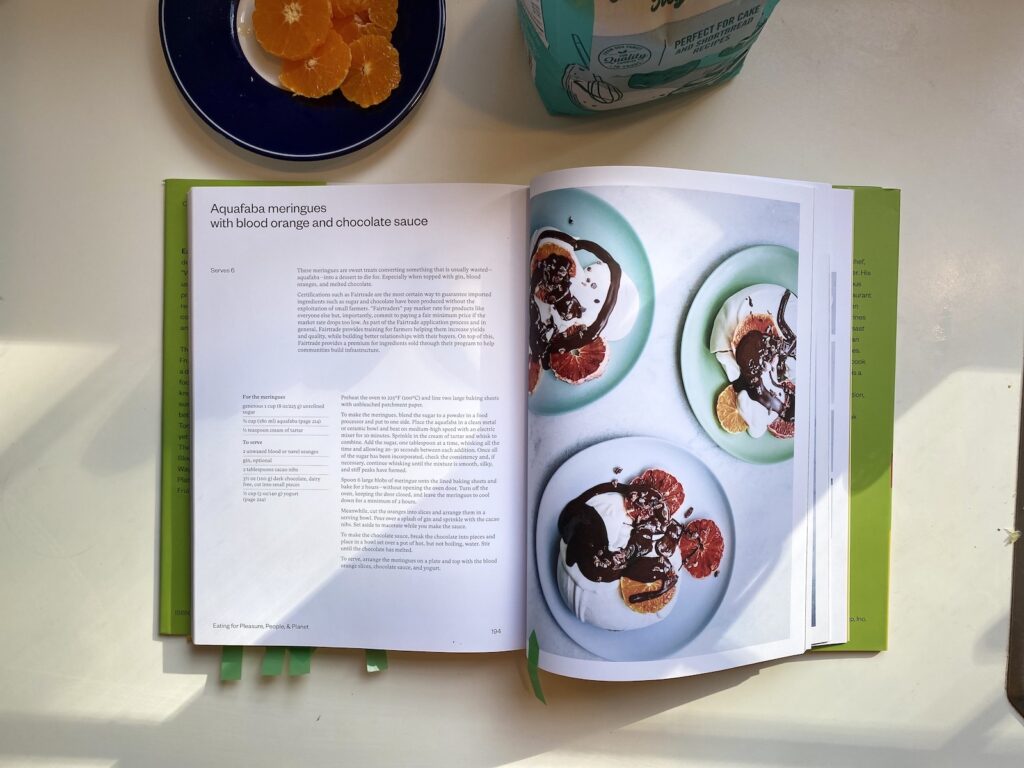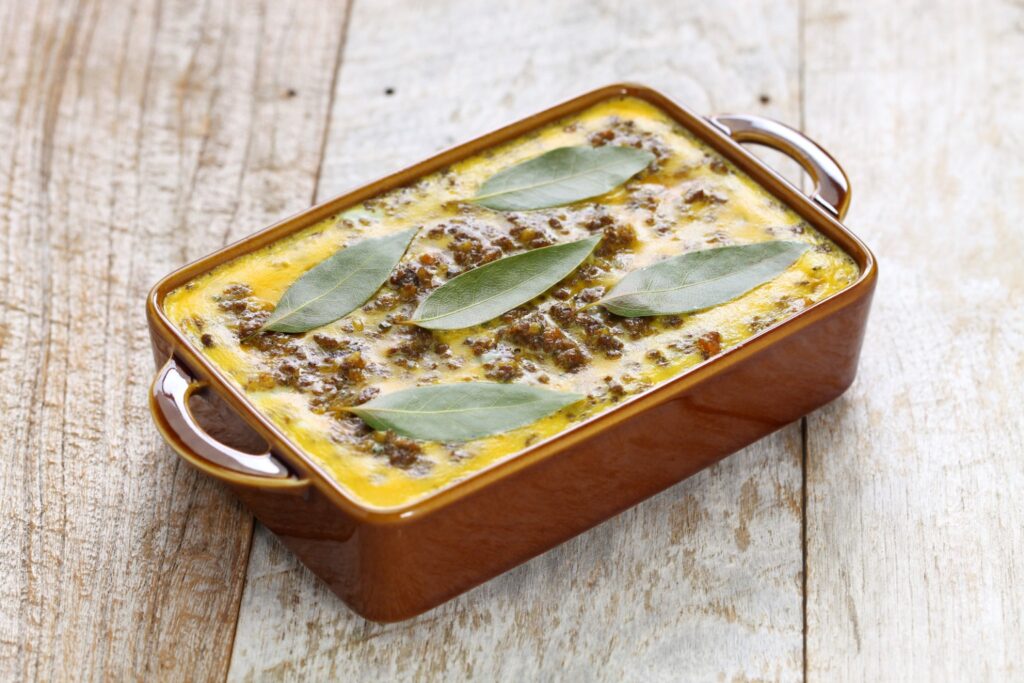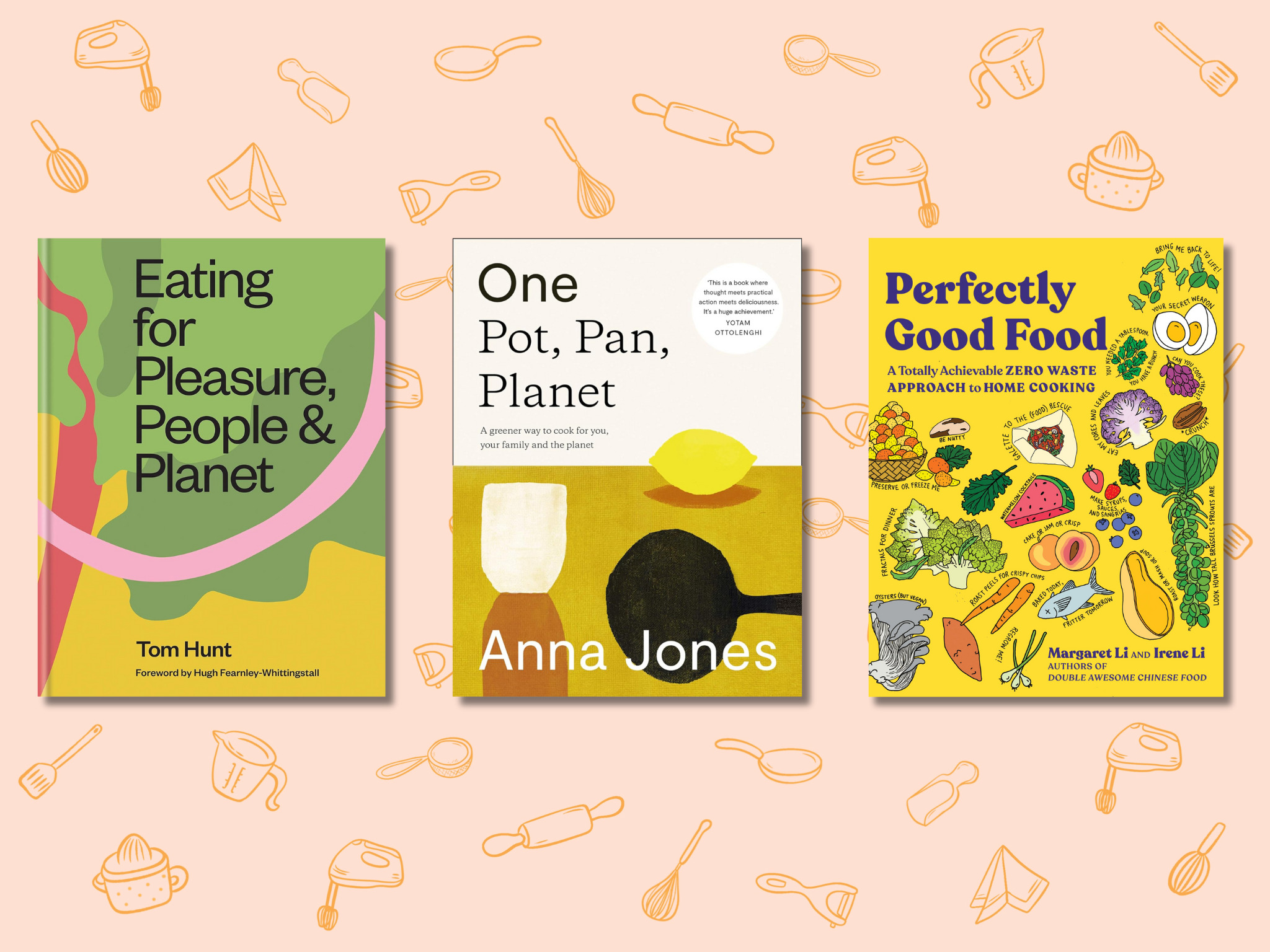12 Mins Read
Sustainable diets have been around for decades, but an emerging cookbook genre signals a new appetite for change.
By Caroline Saunders, Grist
Kitchen Arts & Letters, a legendary cookbook store on Manhattan’s Upper East Side, is tiny — just 750 square feet — but not an inch of space is wasted. With roughly 12,000 different cookbooks and a staff of former chefs and food academics, it’s the land of plenty for those seeking guidance beyond the typical weekday recipe.
One table is piled high with new cookbooks about ramen, eggs, and the many uses of whey, the overflow stacked in leaning towers above the shelves along the walls. One bookcase is packed with nothing but titles about fish. And next to a robust vegetarian section at the back of the store, tucked in a corner, is a minuscule collection of cookbooks about sustainability and climate change.
Natalie Stroud, a sales associate at Kitchen Arts & Letters, pointed me to the five titles featured there. “It’s hard,” she said, “because there aren’t many. But it’s something we’re trying to build out as it becomes more popular.”
One of the cookbooks is Eating for Pleasure, People, and Planet by British chef Tom Hunt. I flip to a recipe titled “a rutabaga pretending to be ham” (with cross-hatching that would make a honey-baked ham blush) and a Dan Barber-inspired “rotation risotto” starring a dealer’s choice of sustainably grown grains. Next to it is Perfectly Good Food: A Totally Achievable Zero Waste Approach to Home Cooking by restaurateur sisters Margaret and Irene Li, full of mad-lib recipes for wilting ingredients like “an endlessly riffable fruit crisp” and a saag paneer that grants ingredients like carrot tops a compost-bin pardon.
What is climate-friendly cooking?
Climate cookbooks seem to be picking up speed in parallel to a trend toward sustainable eating. In 2016, the term “climatarian” entered the Cambridge Dictionary — referring to a person who bases their diet on the lowest possible carbon footprint. In 2020, a survey by the global market research company YouGov found that 1 in 5 U.S. millennials had changed their diets to help the climate. If you consider a climate cookbook to be one that was written, at least in part, to address the dietary changes necessitated by the climate crisis, you can see a whisper of a subgenre beginning to emerge. At least a dozen have been published since 2020.
These cookbooks might play an important role in the transition to sustainable diets. It’s one thing — and certainly a useful thing — for scientists and international organizations to tell people how diets need to change to mitigate and adapt to the climate crisis. It’s another to bring the culinary path forward to life in actual dishes and ingredients. And recipe developers and cookbook authors, whose whole shtick is knowing what will feel doable and inspiring in the glow of the refrigerator light, might be the ones to do it.
I’ve been thinking about this handoff from science communicators to the culinary crowd for a while. I worked at Grist until I went to Le Cordon Bleu Paris to learn how to make sustainable desserts. (Climate cuisine is dead on arrival without good cake.) Now a recipe tester and Substacker with my own dream of a one-day cookbook, I find myself wondering what this early wave of climate cookbooks is serving for dinner.
What does climate cooking mean? And will these cookbooks have any impact on the way average people cook and eat? The emerging genre of climate cookbooks puts a big idea on the menu: that there won’t be one way to eat sustainably in a warming world, but many — à la carte style.

The rise of climate cookbooks
Cookbooks about sustainable ways of eating are nothing new, even if they haven’t used the climate label. M.F.K. Fisher’s World War II-era book How to Cook a Wolf found beauty in cooking what you have and wasting nothing. The comforting recipes in the Moosewood Cookbook helped American vegetarianism unfurl its wings in the 1970s. Eating locally and seasonally is familiar, too. Edna Lewis spread it out on a Virginia table in The Taste of Country Cooking, and Alice Waters turned it into a prix fixe menu and various cookbooks at her Berkeley restaurant Chez Panisse.
But until recently, if you wanted to read about food and climate change, you had to turn to the nonfiction shelves. Books like The Fate of Food by Amanda Little (for which I was a research intern) and The Omnivore’s Dilemma by Michael Pollan swirl the two topics together as smoothly as chocolate and vanilla soft serve, albeit through a journalistic rather than culinary lens. The way we eat is both a driver of climate change — the food system accounts for a third of global greenhouse gas emissions — and an accessible solution. Unlike energy or transportation or the gruel that is national politics, our diets are a problem with solutions as close as the ends of our forks.
It seems only natural that consideration for the climate would eventually waft into recipe writing and cookbooks. In 2019, NYT Cooking created a collection of climate-friendly recipes, albeit a sparse one by their standards, focused on meat alternatives, sustainable seafood, and vegan dishes. In 2021, Epicurious announced it would stop publishing new recipes containing beef, which is about 40 times more carbon-intensive than beans. In parallel, climate cookbooks have begun to proliferate, and so far, they’re offering varied entry points to sustainable eating.
A few recent food waste cookbooks want home cooks to know one thing: that simply using all our food is an undersung climate solution — one often overshadowed by red meat’s gaudier climate villainy. The research organization Project Drawdown lists reducing food waste as the climate solution that could cut the most emissions (closely followed by adopting plant-rich diets), a fact that caught Margaret Li’s attention when she and her sister Irene were writing Perfectly Good Food.
“That kind of blew my mind,” she said. “For people worried about the environment, you think, ‘I should get an electric car, I should eat vegetarian.’ But then you waste all this food and throw it in the landfill. It seems like a pretty important connection to make for people.”
One: Pot, Pan, Planet by the “queen of greens” Anna Jones offers another way in, tinkering with a weeknight style of vegetarianism to make it even better for the environment. Her brightly flavored recipes, which have earned her comparisons to Nigella Lawson and Yotam Ottolenghi, streamline kitchen appliance use (hence: one pot, one pan), saving a lot of time and a little energy and money, too.
Jones has also honed her vegetarian shopping list over time. “The ingredients I’m drawn to have definitely changed,” she said. She now offers substitutions for dairy and eggs as a matter of course (you can use vegan ricotta in her sweet corn and green chili pasta, if you wish!), and she deemphasizes certain plant-based ingredients that come with environmental or social baggage. Water-guzzling almonds and often exploitatively produced chocolate appear on a “tread lightly” list, along with the recommendation to think of them as special treats rather than everyday staples.

Is seasonal and local eating legit?
Other cookbooks take a different approach, offering home cooks a fully developed set of what we might call climate cooking principles.
When chef Tom Hunt wrote his 2020 cookbook Eating for Pleasure, People, and Planet, his goal was “to cover food sustainability in its entirety.” It opens with his “root-to-fruit manifesto,” which he translated from an academic book for a home cook audience and boiled down to a few ideas: plant-based, low-waste, and climate cuisine. By “climate cuisine” he means using local and seasonal ingredients, sourcing from labor- and land-conscious vendors (consider the cover crop, would you, in your next risotto?), and eating a rainbow of biodiverse foods.
Eating seasonally and locally are sometimes dismissed from the climate conversation because they don’t save much carbon, according to experts. But some argue that seasonal food tastes better and can help eaters steer away from climate red flags. Skipping out-of-season produce avoids food grown in energy-sucking greenhouses and stuff that’s flown in by plane, like delicate berries. (Air travel is the only mode of transport that makes food miles a big deal.) And local food comes with an oft-forgotten green flag: Buying from nearby farms strengthens regional food economies, which makes the food system more resilient to climate events and other shocks.
Hunt also makes the case for putting biodiversity on the plate. “Biodiversity has always felt like one of the key elements of this whole situation that we’re in,” he said. Today, nearly half of all the calories people eat around the world come from just three plants: wheat, rice, and maize. “That kind of monoculture is very fragile,” he explained. “People often don’t realize that our food is linked to biodiversity, and the diversity of the food that we eat can support biodiversity in general.”
Biodiversity is also a through line in For People and Planet — a collaboration between the United Nations and the nonprofit Kitchen Connection Alliance with recipes contributed by star chefs, Indigenous home cooks, and farmers. (We’ll call it the U.N. cookbook, since these titles otherwise threaten to blend into an alliterative purée). Its recipes are a global tour of plant-forward culinary biodiversity, like a West African moringa pesto pasta and banana-millet croquettes rolled in puffed amaranth that looks like teensy popcorn.
Published last year, the cookbook is divided into five big ideas: biodiversity, food and climate change, reducing food waste, sustainable consumption, and the food system. The topics came from a U.N. food systems summit, said Earlene Cruz, who is the founder and director of Kitchen Connection Alliance and who compiled the cookbook. They were the ones that “consumers needed more information on, but could also be contributors to in a positive way.”
The chapters on sustainable consumption and the food system argue that a sustainable eating philosophy isn’t complete without consideration of — among other things — resilience and nutrition. What does that mean in dinner form? In Nunavut, Canada, it might mean choosing grilled Arctic char, because it’s part of a nutritionally and culturally important Inuit fishing economy. (Folks in other parts should source it carefully, since seafood is environmentally complicated.) Among the Maasai Indigenous community in Kenya, it might mean serving enkum, a starchy side dish that uses low-cost veggies, since frequent droughts and social unrest make food prices high. The chapters stress communities’ ability to feed themselves healthily, on their own terms, regardless of what climate disruptions may come or what industrial food supply chains may peddle.
The U.N. cookbook raises an important idea: that there won’t be one sustainable diet around the world, but many. Still, the mix of considerations it tosses into the pan — water scarcity, nutrition, food sovereignty, biodiversity, pollution — might leave home cooks slightly overwhelmed. You might shut the book, stomach rumbling, and wonder: OK, well, what should I make for dinner if I care about people and the planet?
What goes into writing a climate cookbook
Coming up with recipes for the planet’s well-being involves a number of considerations. How do you come up with a climate cooking philosophy that’s scientifically rigorous and approachable? What do you do about regionality — the fact that some things, like tomatoes, can be grown sustainably in one part of the world, but might require a greenhouse to grow elsewhere? And how do you handle the climate-offender-in-chief — meat?
Most of the climate cookbook authors mentioned above allow for diets that include animal products. They generally don’t want to turn off omnivores, but the overtures they make to meat-eating vary. Hunt’s cookbook Eating for Pleasure, People, and Planet is plant-based, but he includes advice on sourcing meat and fish sustainably for those who do indulge. The U.N. cookbook opted to include some meat recipes, like a South African beef dish called bobotie that could counter childhood malnutrition. Cruz, who compiled the cookbook, is vegetarian; she just doesn’t like the taste of meat. But, she explains, “if I’m putting my personal views aside, some cultures do need to eat meat to sustain themselves.”

More complicated is picking an ingredient list that will be sustainable for everyone who might use the cookbook, regardless of geography, culture, or socioeconomic status. Amy Trubek, a professor in the department of nutrition and food sciences at the University of Vermont, thinks this is one of the biggest challenges climate cookbook authors will face.
“The glossy cookbook genre now, it’s a hard situation in a way,” she said, “because they’re supposed to be pitching it to any middle- or upper-middle-class consumer anywhere in the United States, and they could be living in a penthouse apartment in Chicago, or they could be living in a ranch in New Mexico. So how do you teach about [sustainable eating] without thinking about specificity and regionality?”
Cookbook authors have a few options. They could write a regionally specific cookbook, or a mass-market one starring ingredients that grow sustainably in lots of places (as One did). Or they could write a cookbook that samples vast biodiversity at some cost to sourceability — that’s the approach the U.N. cookbook took.
“There are many cookbooks that could … have 90 percent of the recipes be part of your staple at home,” Cruz said. “But that serves a different purpose.” The U.N. cookbook is instead “almost a launching point into everyone’s own culinary exploration and everyone’s own culinary journey.”
That exploratory emphasis — embodied not just in the recipes but in accompanying carbon and nutrition calculations and in principles that offer starting points rather than answers — puts it at one end of the spectrum in the balance these authors strike between nuance and approachability, science and art. As Cruz put it, “What we wanted to create was sort of a textbook in disguise.”
One, on the other hand, was always meant to make people pull out a cutting board. Jones includes no small measure of environmental nuance — she tucks articles on issues like soil health and ethical sourcing between her recipe chapters — but her recipes themselves don’t ask the cook to do anything other than make weeknight meals with supermarket ingredients. “I could have foraged for sea buckthorn and written a chapter on sea asparagus,” she laughs, “and I would love for everyone to be foraging. But that’s not the reality … I wanted to write a sustainable cookbook, but I also wanted to write a cookbook filled with recipes people could make.”
Standing out from the crowd
No matter the topic, writing a cookbook is a big undertaking. Authors develop 100 or more recipes, typically handing them off to recipe testers in batches to poke, prod, and polish to infallibility. And while roughly 20 million cookbooks are sold in the U.S. each year, the field is ever more crowded, so it’s harder to stand out.
For now, the climate cookbooks shelf is still tiny, and it’s hard to know which ones readers might be most tempted to pick up — let alone which, if any, might actually create meaningful shifts in what and how we eat.
“People buy cookbooks for myriad reasons,” wrote Matt Sartwell, the managing partner of Kitchen Arts & Letters, in an email to Grist. “But if there is anything that people will pay for — recipes and information being free and abundant on the internet — it’s a clear point of view and the promise that an author has given a subject very serious thought.”
One: Pot, Pan, Planet is Jones’ best-selling cookbook to date, despite the fact that leaning into sustainability “felt like a bit of a risk,” she said.
She has a hunch about why it’s been popular. “People want to try and make a difference,” she said. “I think it felt comforting for people to have a book full of recipes that it felt OK to eat.”
This article by Grist is published here as part of the global journalism collaboration Covering Climate Now.




